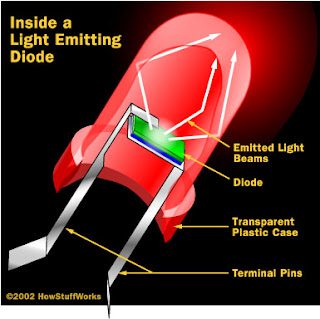A diode is an electronic component (precisely, a semiconductor device) which conducts current in only one direction, that is, when it is forward-biased. A light-emitting diode (LED) is a diode which emits light when forward biased, along with current conduction. A bulb glows when the switch is closed (ON), while it doesn’t when the switch is open (OFF). Likewise, for a LED, forward-biased state represents ON state and reversed biased state represents OFF state.
There are many types of leds, a picture of a few of them is shown below:
WORKING:
An LED works on the principle of photon emission. When current flows across a diode, positive holes moves in one direction while negative electrons (free electrons) move in the opposite direction. The free electrons are situated in the conduction band, while the holes are located in the valence band. Hence, the free electrons have higher energy than the holes. Hence, during recombination, when the free electrons “fall” from conduction band to valence band, the electrons lose energy. This energy loss occurs in the form of light (photon) emission. The size of the “fall” determines the energy content of the photon, and hence the frequency and colour of the light emitted by the LED. A bigger fall corresponds to higher energy of the emitted photons, thus leading to higher frequency of the photon emission.
An LED works on the principle of photon emission. When current flows across a diode, positive holes moves in one direction while negative electrons (free electrons) move in the opposite direction. The free electrons are situated in the conduction band, while the holes are located in the valence band. Hence, the free electrons have higher energy than the holes. Hence, during recombination, when the free electrons “fall” from conduction band to valence band, the electrons lose energy. This energy loss occurs in the form of light (photon) emission. The size of the “fall” determines the energy content of the photon, and hence the frequency and colour of the light emitted by the LED. A bigger fall corresponds to higher energy of the emitted photons, thus leading to higher frequency of the photon emission.
Although this mechanism occurs in normal diodes also, in a typical Silicon-diode, the gap between conduction and valence bands is relatively small, thus the light emitted has lower energy and frequency. Its frequency is so small that photon emission occurs in the Infrared range, which is invisible to the human eye. However a LED is characterized by bigger conduction band- valence band gap, hence the frequency of the light emitted is visible to the human eye. The light emitting semiconductor material present in the LED is Gallium Arsenide(GaAs) and compounds involving GaAs, silicon carbide, gallium phosphide and so on.
I thank howstuffworks.com for this amazing picture.
Here's a video that shows the working of LED:
ADVANTAGES:
LEDs have the following advantages-
- They have a very high efficiency since there is very less heat dissipation compared to incandescent lamps. A much larger percentage of the energy transfer goes into light emission, hence making the electrical power demands very less.
- They can be used in place of lamps and since they don’t have a filament (which can burn out, as in incandescent lamps) and hence they last longer (typically they have a lifespan 50 times that of incandescent lamps).
- Their plastic (epoxy) bulb casing makes them very durable.
- They can fit more easily into modern electronic circuitry.
APPLICATIONS:
LEDs have many practical applications-
- Since LEDs are designed to emit only one colour of light, they are used for traffic lights and signals, conventional and emergency vehicle lighting, ships’ navigation light or lanterns, exit signs etc.
- In digital clocks and related applications as a seven segment display.
- They are used for communication purposes, including broadband data transmission.
- Many systems depend on LED light as their signal source, thus it is extremely useful in optic fibre and free space optic communication.
- LEDs are also used in movement sensors, and hence they have a big role to play in motion-sensing applications.
- Environmental applications involving the mimicry of the photosynthesis process.
- They are also used to detect faults in electronic components such as ICs, as well as in electronic circuitry as a whole.
Thus LEDs are extremely useful electronic components which are very necessary in modern electronics industry.




